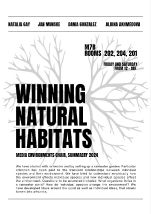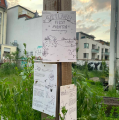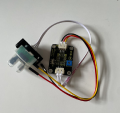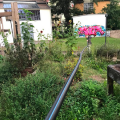No edit summary |
|||
| (9 intermediate revisions by the same user not shown) | |||
| Line 48: | Line 48: | ||
11.07.2024 - Summaery | 11.07.2024 - Summaery | ||
== Students == | |||
[[GMU:Winning_natural_habitats/Natalia Gay Pintado|Natalia Gay Pintado]] | [[GMU:Winning_natural_habitats/Natalia Gay Pintado|Natalia Gay Pintado]] | ||
| Line 56: | Line 56: | ||
[[GMU:Winning natural habitats/Lalicha Lalitsasivimol|Lalicha Lalitsasivimol]] | [[GMU:Winning natural habitats/Lalicha Lalitsasivimol|Lalicha Lalitsasivimol]] | ||
[[GMU:Winning natural habitats/Dania González Sanabria|Dania González Sanabria]] | [[GMU:Winning natural habitats/Dania González Sanabria|Dania González Sanabria]] | ||
| Line 67: | Line 67: | ||
Melika Sadeghzadeh (guest) | Melika Sadeghzadeh (guest) | ||
== Exhibition (Summaery 2024) == | |||
[[File:Poster8.jpg|thumb|214x214px]] | |||
* Jan Munske -- performative video work in 204 (the dance floor) | * Jan Munske -- performative video work in 204 (the dance floor) | ||
* Albina Akhmedova -- a short documentary about the biodiversity of the pond in 201 | * Albina Akhmedova -- a short documentary about the biodiversity of the pond in 201 | ||
| Line 76: | Line 77: | ||
Research site at the pond | Research site at the pond | ||
== Class proyect: wetland as a piece of living environmental art and research == | |||
A natural wetland is an area of land saturated with water, where the water table is at or near the surface. These ecosystems are characterized by the presence of water-loving plants and a high degree of biological productivity.Building your own natural wetland or pond can offer numerous environmental benefits. | A natural wetland is an area of land saturated with water, where the water table is at or near the surface. These ecosystems are characterized by the presence of water-loving plants and a high degree of biological productivity.Building your own natural wetland or pond can offer numerous environmental benefits. | ||
| Line 104: | Line 105: | ||
File:Flora in wetland2.png|flora in wetland | File:Flora in wetland2.png|flora in wetland | ||
File:Materials for the bilboards.png|materials for the bilboards | File:Materials for the bilboards.png|materials for the bilboards | ||
File:Billboards.png|billboards in the wetland | |||
File:Camera9.png | |||
File:Camera8.png|camera instalation | File:Camera8.png|camera instalation | ||
File:The wetland in the 30th anniversary .png|the wetland in the 30th anniversary of the Faculty of Art and Design | File:The wetland in the 30th anniversary .png|the wetland in the 30th anniversary of the Faculty of Art and Design | ||
File:Research in the laboratory.png|research in the laboratory | File:Research in the laboratory.png|research in the laboratory | ||
| Line 117: | Line 118: | ||
</gallery> | </gallery> | ||
== Wetland's first month anniversary == | |||
We created a small zine to help spread the word about creating your own wetland in simple steps and the importance of biodiversity and | We created a small zine to help spread the word about creating your own wetland in simple steps and the importance of biodiversity and nature in urban or human spaces. | ||
The publication also celebrated the first month of life of our wetland and was first distributed in the 30th anniversary of the Faculty of Art and Design. | The publication also celebrated the first month of life of our wetland and was first distributed in the 30th anniversary of the Faculty of Art and Design. | ||
| Line 125: | Line 126: | ||
File:Zine1.jpg | File:Zine1.jpg | ||
File:Zine2.jpg | File:Zine2.jpg | ||
File:Zine4.jpg | |||
File:Zine5.jpg | File:Zine5.jpg | ||
File: | File:Booklet instructions.png|booklet instructions | ||
File:Booklet7.png | |||
</gallery> | </gallery> | ||
== Photos == | |||
<gallery> | <gallery> | ||
File:KlausIMG 1423.jpg | File:KlausIMG 1423.jpg | ||
Latest revision as of 12:27, 7 September 2024
Lecturer(s): Mindaugas Gapševičius & Klaus Fritze
Credits: 4 SWS
Date: Thursdays, 9.15-12.30
Venue: DIY Biolab @ Marienstraße 7b, Room 202
First meeting: 18.04.2024
We will start with rainwater and semi-controlled environments populated by selected organisms. Particular attention will be paid to the transient relationships between individual species and their environment. As we track changes in the semi-controlled environment, we will learn how to work with photosynthetic organisms. We will also try to understand empirically how the environment affects individual species and how individual species affect the environment. Questions to be answered include: Could the use of populated water puddles clean the air? How do different pH levels affect organisms and their environment? How do individual species change the environment?
As we learn to take practical care of our wet environment and conduct artistic research, we will develop our ideas and slowly turn them into artworks. The experiments will be documented in detail in a wiki that will serve as the basis for our weekly discussions and as a means of evaluating the course work.
The course is designed for the use of a wide range of tools, including laboratory and techno-scientific tools. We will be working with rainwater as well as cooking our own media. During our experiments we will conduct field research, use our DIY bio lab and seminar room as needed.
Part of the course is a block workshop Ecosystem services with environmental scientist Outi Wahlroos (FI). The workshop was developed to acknowledge the services which nature can offer humans. The aim is to raise awareness of the fact that without a nurturing and healthy environment, humans do suffer. The workshop is scheduled for April 25-27.
File:2024 presentation Miga und Klaus GMU.pdf
Syllabus
18.04.2024 - /Introduction
25-27.04.2024 - /Wetland Ecosystem Services Workshop
02.05.2024 - /Algae cultures (Klaus) and Maintenance of wetland
09.05.2024 - Holidays
16.05.2024 - /Ideas workshop
23.05.2024 - /Ideas workshop & /Pond microdiversity (Klaus)
30.05.2024 - /Ideas workshop & /Pond microdiversity (miga)
06.05.2024 - /Midterm presentation
13.06.2024 -
20.06.2024 -
27.06.2024 - /Project tuning (Klaus)
04.07.2024 - /Final project presentation
11.07.2024 - Summaery
Students
Sabah Khaled Abouelhadid Elsay Hassan
Melika Sadeghzadeh (guest)
Exhibition (Summaery 2024)
- Jan Munske -- performative video work in 204 (the dance floor)
- Albina Akhmedova -- a short documentary about the biodiversity of the pond in 201
- Dania González Sanabria -- terrarium with plants in 204 + workshop in the garden Friday or Saturday
- Natalia Gay Pintado -- a book on microscopic images and patterns in 202
Research site at the pond
Class proyect: wetland as a piece of living environmental art and research
A natural wetland is an area of land saturated with water, where the water table is at or near the surface. These ecosystems are characterized by the presence of water-loving plants and a high degree of biological productivity.Building your own natural wetland or pond can offer numerous environmental benefits.
Creating a wetland or pond can provide a habitat for a wide range of wildlife, including birds, amphibians, fish, and insects. This supports local biodiversity and promotes ecological balance. Wetlands naturally filter and purify water by trapping sediments, absorbing pollutants, and breaking down organic matter, improving water quality in the surrounding area. They can act as natural sponges, effectively managing stormwater runoff and reducing the risk of flooding. Wetlands store carbon in their plant biomass and soil, helping to mitigate the effects of climate change by reducing atmospheric carbon dioxide levels.
Additionally, building a pond is a rewarding project that keeps you engaged for quite some days. Observing the pond during its growth process is fantastic, offering much to see, smell, listen to, and track. Once you’ve set the pond, you’ll see it become self-sustaining, providing a wealth of experiences in return.
Hereunder you can find some photos of our process and research.
Wetland's first month anniversary
We created a small zine to help spread the word about creating your own wetland in simple steps and the importance of biodiversity and nature in urban or human spaces.
The publication also celebrated the first month of life of our wetland and was first distributed in the 30th anniversary of the Faculty of Art and Design.








































